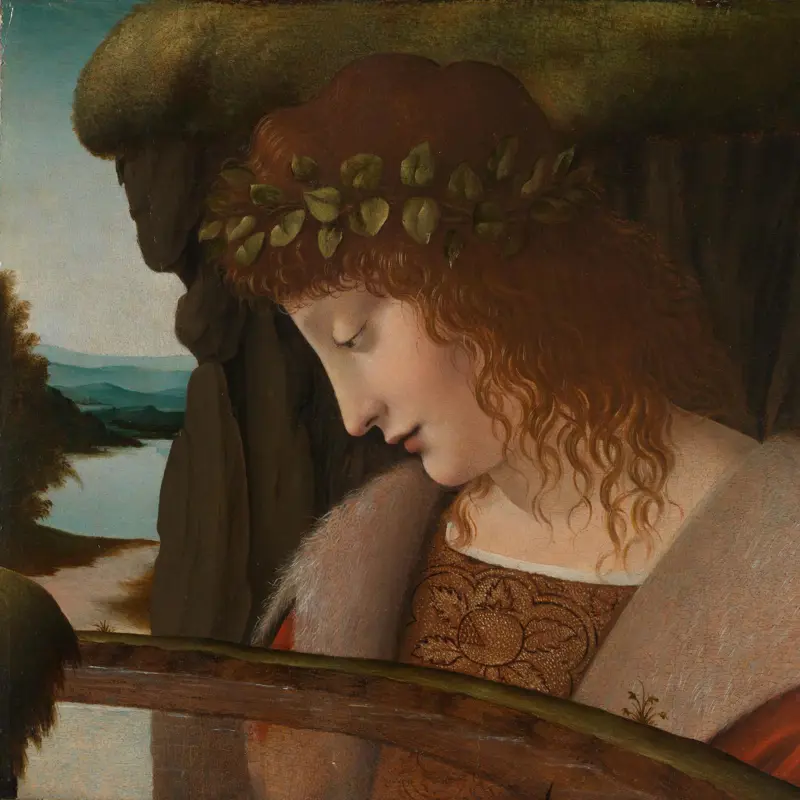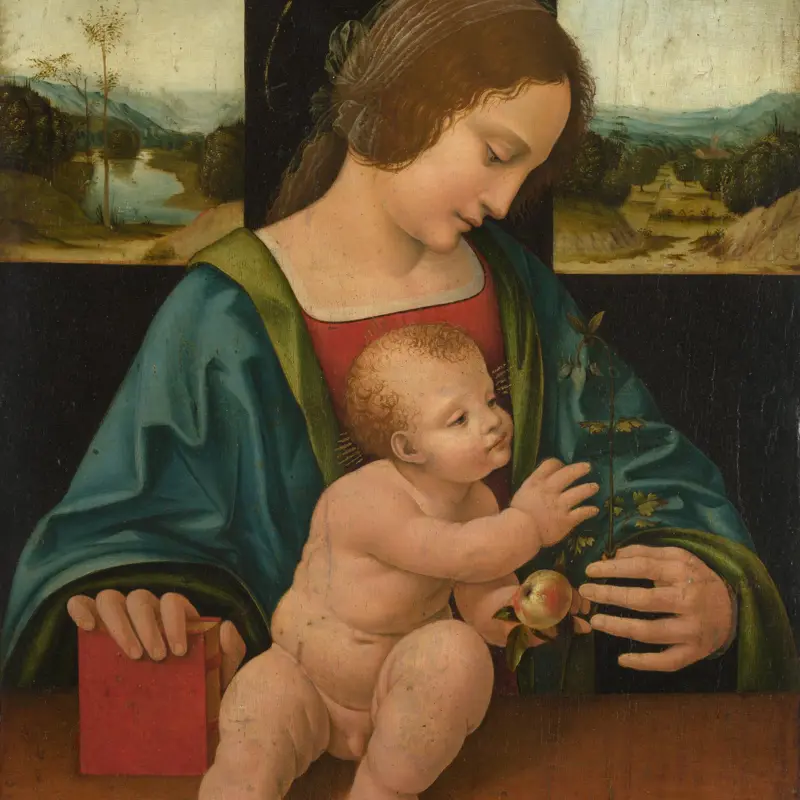Giovanni Antonio Boltraffio, 'The Virgin and Child', probably about 1493-9
About the work
Overview
A grave, statuesque young woman gazes down at a positively enormous child, who lies sideways across her lap. Her deep red gown is open to reveal her breast, which she offers to her son – though he seems uninterested. He turns his head away from his mother to look out at the viewer, at the same time playing with the beads which dangle from her scarf.
Although we know from their delicate haloes that these are the Virgin Mary and infant Christ, this is a very modern Mary, painted in a newly realistic manner. Boltraffio was Leonardo da Vinci’s most gifted pupil, and imitated his master in style and technique. Both mother and child have a palpable physical presence and, although idealised, are clearly made of flesh and blood – a simple mother lovingly cradling her son.
The centrality of the composition and the low viewpoint suggest that this might once have been the central panel of a large altarpiece.
Key facts
Details
- Full title
- The Virgin and Child
- Artist
- Giovanni Antonio Boltraffio
- Artist dates
- About 1467 - 1516
- Date made
- Probably about 1493-9
- Medium and support
- Oil on wood (walnut, identified)
- Dimensions
- 92.7 × 67.3 cm
- Acquisition credit
- Bought, 1863
- Inventory number
- NG728
- Location
- Not on display
- Collection
- Main Collection
- Previous owners
Provenance
Additional information
Text extracted from the ‘Provenance’ section of the catalogue entry in Martin Davies, ‘National Gallery Catalogues: The Earlier Italian Schools’, London 1986; for further information, see the full catalogue entry.
Bibliography
-
1846'Visits to Private Galleries, No. XVI: The Collection of the Right Hon. Lord Northwick, at Northwick Park, Worcestershire', Art Union, VIII, 1846, pp. 271-4
-
1847British Institution, Catalogue of Pictures by Italian, Spanish, Flemish, Dutch, French and English Masters, with which the Proprietors have Favoured the Institution: June 1847, London 1847
-
1847British Institution, Catalogue of Pictures by Italian, Spanish, Flemish, Dutch, French and English Masters (exh. cat. British Institution, 1847), London 1847
-
1854G.F. Waagen, Treasures of Art in Great Britain: Being and Account of the Chief Collections of Paintings, Drawings, Sculptures, Illuminated Mss. […], vol. 2, trans. E. Eastlake, London 1854
-
1859Phillips, Catalogue of the Late Lord Northwick's Extensive and Magnificent Collection of Ancient and Modern Pictures…, Phillips, Thirlestane House, Cheltenham, 26 July 1859, Cheltenham, 26 July 1859 - 30 August 1859
-
1863Christie, Manson & Woods, Catalogue of the Celebrated Collection of Pictures of the Rev. Walter Davenport Bromley, London, 12 June 1863
-
1951Davies, Martin, National Gallery Catalogues: The Earlier Italian Schools, London 1951
-
1959R.R. Henry, Giovanni Antonio Boltraffio: A Stylistic Study of His Work, Phd Thesis, Boston University Graduate School 1959
-
1961M. Davies, The Earlier Italian Schools, 2nd edn, London 1961
-
1978D. Robertson, Sir Charles Eastlake and the Victorian Art World, Princeton 1978
-
1986Davies, Martin, National Gallery Catalogues: The Earlier Italian Schools, revised edn, London 1986
-
1996L. Keith and A. Roy, 'Giampietrino, Boltraffio, and the Influence of Leonardo', National Gallery Technical Bulletin, XVII, 1996, pp. 4-19
-
1996J. Kirby and R. White, 'The Identification of Red Lake Pigment Dyestuffs and a Discussion of their Use', National Gallery Technical Bulletin, XVII, 1996, pp. 56-80
-
1996R. White and J. Pilc, 'Analyses of Paint Media', National Gallery Technical Bulletin, XVII, 1996, pp. 91-103
-
2001
C. Baker and T. Henry, The National Gallery: Complete Illustrated Catalogue, London 2001
About this record
If you know more about this work or have spotted an error, please contact us. Please note that exhibition histories are listed from 2009 onwards. Bibliographies may not be complete; more comprehensive information is available in the National Gallery Library.



